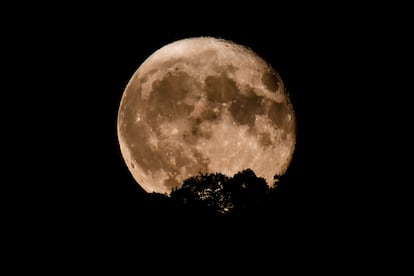Blue moon tonight: How to see the largest full moon of 2023
Despite its popular name, during the blue moon phase our satellite will not look a different shade than usual


The final throes of August will provide stargazers with the biggest and brightest full moon of the year. The phenomenon, commonly known as a supermoon, occurs when the perigee (the point in the lunar orbit when our satellite is closest to Earth) coincides with the full moon phase. From the point of view of the terrestrial observer, the moon will appear slightly larger (up to 7%) and brighter (up to 15%) than usual.
At around 357,300 kilometers (222,015 miles) away from Earth, in contrast to the 384,400 kilometers (238,855 miles) that on average separate the two stars, the supermoon of August 30 will officially turn full at 9:36 p.m. ET (7:36 p.m. CST / 2:36 a.m. on Thursday in the U.K.) and will traverse the sky in an east-west direction for the rest of the night, until it disappears at dawn. The phenomenon will continue to be visible to a lesser extent during night of August 31.
Although the supermoon will reach its highest point in the sky around midnight, the best time to capture photos or videos occurs earlier Wednesday, just after it crests the horizon. In addition to the ocher hue it takes on due to the scattering of light in the atmosphere when it is at a lower altitude, the presence of other objects such as buildings, mountains, or trees causes an optical effect that increases its size further.
NEWS 🚨: A rare 'blue supermoon' will appear in the night sky tomorrow (Aug. 30)
— Latest in space (@latestinspace) August 29, 2023
It's reported to be the biggest and brightest moon this year pic.twitter.com/tFHKbCPJ6c
Blue moon or supermoon?
Harvest moon, corn moon, blue moon, supermoon… the names given to the full moons that occur each month do not describe a particular astronomical phenomenon, nor do they encompass any scientific concept. They are popular expressions, derived from the mystery surrounding the Earth’s natural satellite and the relationships that, from the perspective of different ancient cultures, were established between the weather, the seasons, and agriculture based on the periodic appearance of the satellite. The names of the most well-known moons today originate from the Maine-based Farmer’s Almanac, a publication that during the 1930s compiled the various nicknames given to the moon throughout the year by Native American peoples, a tradition that NASA has recently reinstated. Hence, for example, the August moon is known as a harvest, corn, or hunter’s moon.
The full moon on August 30 is both a supermoon and a blue moon. While the term supermoon gained popularity in the 1980s to arbitrarily name the coincidence between the full moon and the perigee, blue moon is an expression that simply describes the second full moon of the same month. Despite its name, during the blue moon phase our satellite will not look a different shade than usual. The only anomaly — taking into account that the lunar cycle lasts 29 days and the months in the Gregorian calendar extend from 28 to 31 days — will be its appearance for the second time in the same month, a phenomenon that is repeated approximately every 2.5 years.
Sign up for our weekly newsletter to get more English-language news coverage from EL PAÍS USA Edition
Tu suscripción se está usando en otro dispositivo
¿Quieres añadir otro usuario a tu suscripción?
Si continúas leyendo en este dispositivo, no se podrá leer en el otro.
FlechaTu suscripción se está usando en otro dispositivo y solo puedes acceder a EL PAÍS desde un dispositivo a la vez.
Si quieres compartir tu cuenta, cambia tu suscripción a la modalidad Premium, así podrás añadir otro usuario. Cada uno accederá con su propia cuenta de email, lo que os permitirá personalizar vuestra experiencia en EL PAÍS.
¿Tienes una suscripción de empresa? Accede aquí para contratar más cuentas.
En el caso de no saber quién está usando tu cuenta, te recomendamos cambiar tu contraseña aquí.
Si decides continuar compartiendo tu cuenta, este mensaje se mostrará en tu dispositivo y en el de la otra persona que está usando tu cuenta de forma indefinida, afectando a tu experiencia de lectura. Puedes consultar aquí los términos y condiciones de la suscripción digital.
More information
Archived In
Últimas noticias
Susan Boyle prepares a comeback just as Timothée Chalamet sings her praises
Trump suspends green card visa lottery after shooting at Brown University
When things get out of hand at the lab: Hundreds of accidents expose the ‘catastrophic’ risk of dangerous pathogen leaks
Venezuelan migrants contribute billions of dollars to Latin America, but continue to work in the informal sector
Most viewed
- Christian Louboutin: ‘Young people don’t want to be like their parents. And if their parents wear sneakers, they’re going to look for something else’
- Cartels in Mexico take a leap forward with narco-drones: ‘It is criminal groups that are leading the innovation race’
- Liset Menéndez de la Prida, neuroscientist: ‘It’s not normal to constantly seek pleasure; it’s important to be bored, to be calm’
- ‘El Limones’ and the growing union disguise of Mexican organized crime
- The low-cost creative revolution: How technology is making art accessible to everyone










































